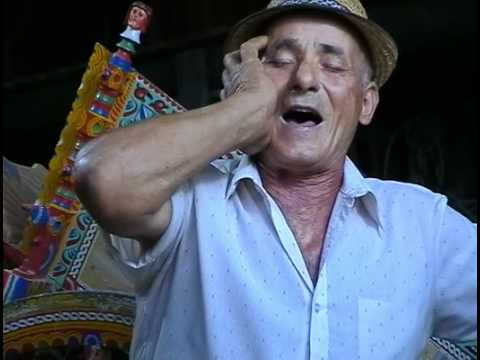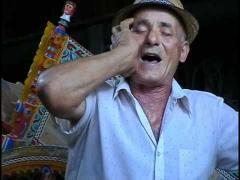Singers at the Carrettiera
Street View (if present)
Description
Singers at the Carrettiera
The carters, during the journey for the delivery of goods, stopped, for rest or for refreshment, in thefondaci (sort of taverns scattered along the main transport routes where the carriers e the carters found lodging for themselves and their beasts). Here, therefore, the carters met with others and often, for pleasure, they sang songs and organized singing competitions, challenging whoever knew the most beautiful song or who possessed the best cadence. To close each execution there was the so-calledcall, that is, two hendecasyllable lines introduced freely by the cantor to invite another challenger, or the last two lines contained thanks for listening, an apology for a bad performance or indicated the origin of the song or the performer. Even on the occasion of festivals or village fairs, the carter took the opportunity to show off: he barded horse and cart at party, wore traditional costumes and performed with his singing skills. The proudest carters refined their skills by comparing themselves with the most expert masters and therefore handed down a real art, whose expressive code seemed to be known and shared by carters from different countries. Thus the art of the carter singers has come down to us, handed down from voice to voice and kept alive by now by few examples, children or relatives of elderly carters.
This type of chants belong to the defined poetic category jay, composed mostly of 8 hendecasyllables in alternating rhyme, but there are also stanzas of 6-10 lines, rare those composed of 4 or 12. The singing performance requires great skill, powerful and correct voice, melodic freedom is granted but the rhythm always falls within precise metric schemes, even the respiratory articulation (the breath that interrupts the melody) marks precise pauses and gives the singing a refined structural value. The repertoire is drawn from various themes: from the religious text to the love one, from the prisoner's song to the working songs. (Text source: Rei data sheet - Sicily region)
----------------
Technical sheet prepared by: Region of Sicily - Department of cultural heritage and Sicilian identity - CRicd: Regional center for inventory, cataloging and documentation and Sicilian regional film library
Intangible Heritage Register
N. Prog. 33
Good: Cantori alla Carrettiera
Book: REI - Book of expressions
Approval date: 25-01-2006
Category: Musical expression
Province: Palermo
Municipality: Bagheria
Local denomination: The song a la carrittera
Actors
The performers of the song are the carters, a now extinct profession, but of which the singing art handed down from voice to voice persists. Even today some children or relatives of elderly carters know how to perform the melodic "carter songs".
The carter was a transporter of goods on behalf of third parties, providing his own means (the cart and the horse, or the mule for the less well-off). Some were employed by a cart owner.
Description
The carters, during the journey for the delivery of goods, stopped, for rest or for refreshment, in thefondaci (sort of taverns scattered along the main transport routes where the carriers e the carters found lodging for themselves and their beasts). Here, therefore, the carters met with others and often, for pleasure, they sang songs and organized singing competitions, challenging whoever knew the most beautiful song or who possessed the best cadence. To close each execution there was the so-calledcall, that is, two hendecasyllable lines introduced freely by the cantor to invite another challenger, or the last two lines contained thanks for listening, an apology for a bad performance or indicated the origin of the song or the performer. Even on the occasion of festivals or village fairs, the carter took the opportunity to show off: he barded horse and cart at party, wore traditional costumes and performed with his singing skills. The proudest carters refined their skills by comparing themselves with the most expert masters and therefore handed down a real art, whose expressive code seemed to be known and shared by carters from different countries. Thus the art of the carter singers has come down to us, handed down from voice to voice and kept alive by now by few examples, children or relatives of elderly carters.
This type of chants belong to the defined poetic category jay, composed mostly of 8 hendecasyllables in alternating rhyme, but there are also stanzas of 6-10 lines, rare those composed of 4 or 12. The singing performance requires great skill, powerful and correct voice, melodic freedom is granted but the rhythm always falls within precise metric schemes, even the respiratory articulation (the breath that interrupts the melody) marks precise pauses and gives the singing a refined structural value. The repertoire is drawn from various themes: from the religious text to the love one, from the prisoner's song to the working songs.
Catalog Sheet
REFERENCES
CRICD. 2004. Bulletin of the tape library. Events and documents. Curated by Orietta Sorgi. Palermo: CRICD
1991. The carters. Curated by Elsa Guggino. Palermo: Archive of Sicilian folk traditions.
Sitography
Discography
Garofalo G; By Salvo Giovanni; Vaina Pierre (Editor)
2006 Canzuna a la carrittera. The singers of Bagheria (Sicily), from FontiMusicali, Brussels (compact disc fmd 230 with 36-page booklet; texts in French, English and Italian)
2006 Canzuna a la carrittera. The singers of Bagheria (Sicily), from FontiMusicali, Brussels (compact disc fmd 230 with 36-page booklet; texts in French, English and Italian)
Footnotes
Author Profile: Mariangela Riggio

Go to Google Maps
Send a notice to the publisher
[contact-form-7 id="18385"]




